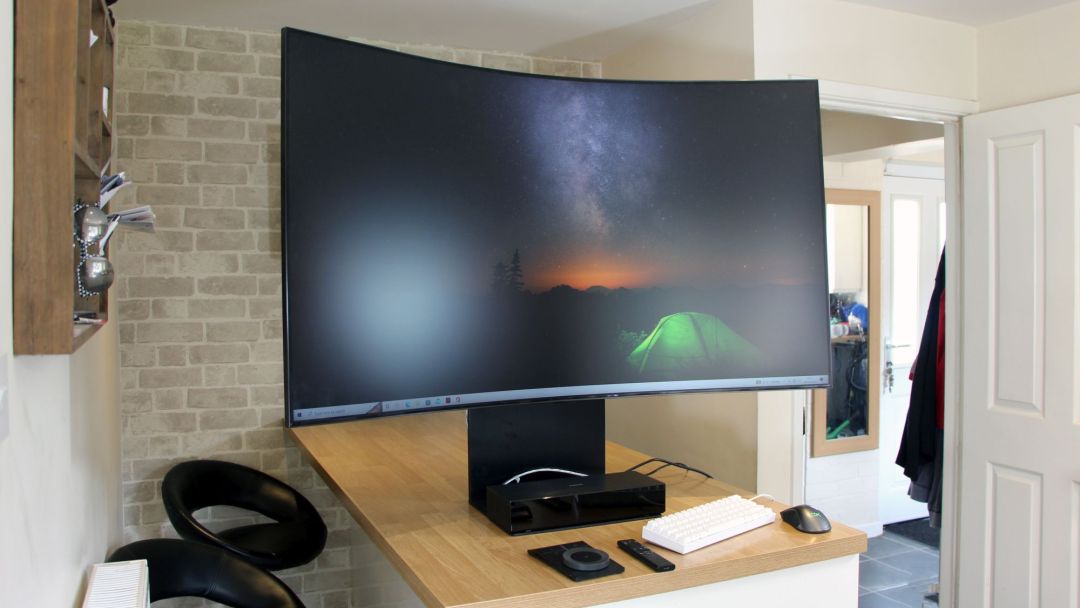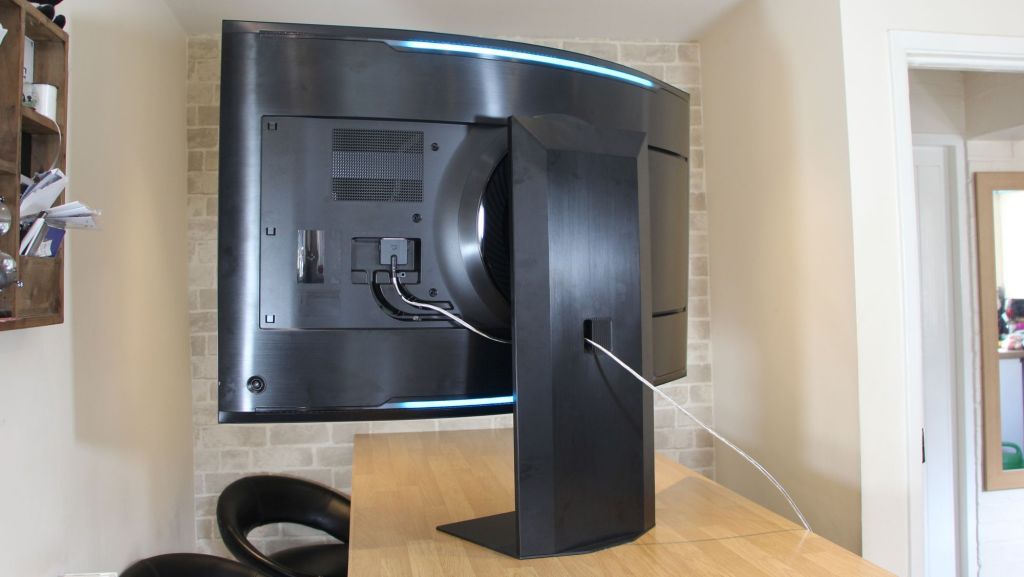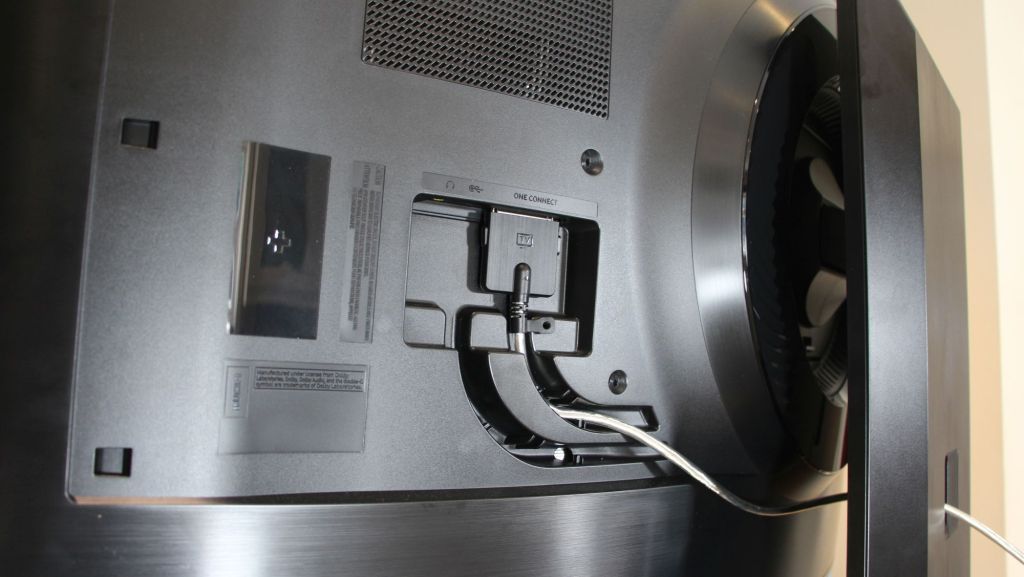Samsung Odyssey Ark review: bigger than big
Can the world's biggest gaming monitor beat TVs at their own game – and justify a vast £2599 price?

The Samsung Odyssey Ark is one of the most outrageous gaming monitors ever made. Think we’re exaggerating? Just look at the specs: it’s a 55in curved beast with eye-searing HDR and a 4K resolution.
It’s the kind of screen that can make every game look incredible, and Samsung doesn’t stop there – the Ark has loads of smart TV features, too, so the firm reckons it can find a home in your living room.
At £2599, though, you’ll need deep pockets to invest in the Ark. And when you can get a great gaming monitor or a flagship TV for that money, can the Odyssey deliver the best of both?
Design & Features: ahead of the curve
The Ark’s 55in diagonal is instantly immersive – but intimidating, too. Sit too close and you’ll hurt your neck trying to see corners. Instead, the Ark works best if you lean back in a gaming chair with a keyboard and mouse or if you’re on the sofa.
When you’ve got the position right, the size, 4K resolution and 1000R curve provide an incredible, immersive experience. The radius of that curve is important, too: it matches the shape of the human eye, which means better viewing angles.
The Ark’s 16:9 aspect ratio suits most games, especially big single-player titles. But Samsung’s got you covered if you want a different size or shape, too: you can reconfigure the panel to 21:9 or 32:9 resolutions if you’d prefer a wider view in racing games. You can also make the screen smaller and adjust its position, which is handy if you want something more compact.
The versatility doesn’t stop. Samsung’s Multi View mode divides the display into several windows. When the Ark is horizontal you get four 1080p tiles, and in the vertical Cockpit Mode you can deploy three windows. You’re in luck if you want to game, watch streams or use IM tools simultaneously.


It’s impressive, but not infallible. When used vertically, your three windows only run at 1280 x 720, making games look blurry. They only run at 120Hz in this mode, too. And while you can use your PC, the YouTube app, a web browser and a mirrored smartphone or laptop display in Multi View, most apps aren’t supported and you can only deploy one HDMI input. Multi View is useful, but right now you certainly just can’t throw anything into its three or four windows.
Happily, Samsung’s software situation improves. On the Smart TV side the Ark supports every app you’ll need, it includes game streaming from Xbox, Nvidia and Stadia, and it runs on familiar Tizen software. The Ark comes with a conventional remote control and the solar-powered Ark Dial, which uses a large wheel for quick tweaks. The on-screen menus are responsive. In-built Bluetooth support also means easy connectivity for your controllers.
The VA screen itself impresses, too. Samsung’s Quantum Mini LEDs mirror the Mini LED tech you’ll find on TVs, which means you get more than 1,000 dimming zones. It’s great at creating top-notch contrast and was also used in Samsung’s own Odyssey Neo G8.

While there’s lots to like about Quantum Mini LED, proper OLED is still better. If you prize picture quality over refresh rate and curve, top TVs like the Sony XR-55A95K and Philips 65OLED+936 deliver true OLED tech inside sleeker designs for the same sort of price as the Ark.
The Samsung may not have OLED, but its 165Hz refresh rate surpasses those TVs. It’s superb for single-player gaming and works well with casual esports games, so you’ll only want something faster if you’re really serious about esports. Make sure you’ve got a capable graphics card, too: you’ll need something like an Nvidia GeForce RTX 3080 Ti to get the most out of the display.
Samsung crams this tech inside a screen that weighs a monster 41.5kg. The Ark’s sheer heft means installation is a two-person job, and at 1175mm wide and 379mm deep you’ll need a large desk or TV stand to support this unit. Sadly, the Ark’s huge stand and visible bezels mean it looks worse than most flagship TVs, too, and it does have RGB LEDs at the rear – but they’re not bright or impressive.

At least excellent adjustment options justify the Ark’s sheer size. There’s a mighty 270mm of height adjustment alongside tilt movement and VESA support – that’s more than most TVs. On top of that, its vertical Cockpit Mode looms above users and delivers an amazing experience in shooters.
You don’t have to mess around with cables at the rear, either: Samsung’s One Connect box makes its way over from the TV range. You can plug your devices into four future-proofed HDMI 2.1 ports and use one cable to connect to the screen. It has wired and wireless internet alongside USB ports, although none are fast.
Performance: excellent by definition
Once you and a friend have hauled Samsung’s monster monitor into position you’ll be blown away by its quality. The Quantum Mini LEDs deliver an inky black point of 0.02 nits and in SDR mode the display hits a 742-nit brightness level. Contrast sits at a superb 4,500:1, and the Ark’s brightness and contrast hit 1226 nits and 61,300:1 in HDR mode. Those top-notch results mean games look bold, deep and nuanced.
Samsung’s screen does a great job with colours, too. The Delta E of 2.29 is rock-solid, and the panel rendered all of the sRGB gamut and almost all of the DCI-P3 space, so it can easily render SDR and HDR games.

Every single game, movie and TV show looks brilliant on the Ark. It’s class-leading performance when it comes to gaming monitors. But if you’re really concerned with quality, you’ll still get better SDR and HDR performance from a top OLED TV.
The Ark’s 165Hz refresh rate makes single-player games and mainstream esports titles look butter-smooth, and it goes beyond the 120Hz and 144Hz rating offered by most top TVs. If you want to play competitive games, though, a 240Hz or 360Hz screen is better.

It’s a similar situation with response time: Samsung claims 1ms, but the Ark doesn’t quite meet that figure in tests. You won’t notice any slowdown in mainstream games, but you’ll want another screen to trouble the top of leaderboards.
Games look fantastic on the Ark. They sound great, too: around the rear you’ll find four speakers and two woofers that produce 60W of power. They’re superb, with huge bass, a crisp high-end and detailed mid-range, and the Ark excels at directional sound. Flagship TVs remain better, but the Ark’s audio easily outstrips any gaming monitor.
Verdict
Samsung’s big screen delivers a stunning experience. Its size, curve and resolution combine for unparalleled levels of immersion, and its image quality is great. There’s no doubt that the Ark exceeds virtually every other gaming display unless you want a specialist screen for racing or esports.
Elsewhere, though, it’s a bit of a mixed bag. Positively, it’s got great smart TV features, intuitive controls, loads of physical adjustment options and a smooth 165Hz refresh rate. Negatively, you’ll get better OLED quality from flagship TVs, the Ark’s Multi View mode and connectivity could both be improved, and this screen is huge, heavy and expensive.
The Samsung Odyssey Ark doesn’t get everything right, but it does deliver excellent image quality, a bold and absorbing form factor and a healthy range of features – so it does a great job of blurring the lines between monitors and TVs. If you want one screen for PC gaming, console play and watching media, the Ark does a tremendous job – just be aware of its shortcomings and its price before you part with cash.
Stuff Says…
An incredible design and impressive image quality create an immersive game and media experience, but the Ark is hugely expensive, not without flaws, and not the ideal choice for some gamers and media fans
Good Stuff
Incredible big-screen, high-resolution design
Great contrast and colour performance
Loads of software options
Punchy speakers and good adjustment ability
Bad Stuff
Refresh rate could be better
OLED TVs remain superior
Extremely expensive
Some disappointing connectivity
Tech specs
| Resolution | 3840 x 2160 |
| Refresh rate | 165Hz AMD FreeSync Premium Pro |
| Size | 55in |
| Curve | 1000R |
| Ports | 4 x HDMI 2.1, 1 x USB-C, 1 x audio, 2 x USB 2.0 |
| Dimensions | 1174 x 1102 x 379mm, 41.5kg |
